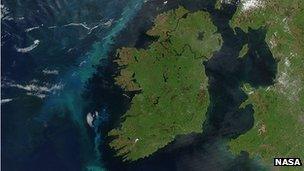Key to ocean life shows large regional variations
- Published

Plant plankton blooms in the ocean can be seen from space.
Iron, key for ocean plant plankton growth, shows larger variations than previously recognised, with implications for models of climate.
Microscopic marine plants, phytoplankton, lock up atmospheric carbon dioxide, but a lack of iron limits photosynthesis.
In Nature Communications, researchers report regional iron variations in the oceans of up to 10,000 times.
This observation is expected to improve ocean-climate models.
Photosynthetic life is limited by low availability of iron in as much as one third of Earth's surface oceans. The problem for phytoplankton is particularly acute around the Southern Ocean.
Dr Will Homoky, lead author of the paper by teams at the Universities of Southampton and South Carolina, said: "Iron acts like a giant lever on marine life, storing carbon. It switches on growth of microscopic marine plants, which extract carbon dioxide from our atmosphere and lock it away in the ocean."
In separate studies, scientists have previously added iron to the ocean in iron-limited areas, which typically generates large blooms of phytoplankton. This has been suggested by some as a possible geoengineering solution to capture carbon from the atmosphere and transfer it to the ocean.
It remains unclear what the fate of phytoplankton carbon, at the base of the food chain is, however, and the role of iron for fertilising the oceans is a developing field of research.
Dr Homoky commented: "Satellite images of the oceans show less phytoplankton growth in the eastern South Atlantic off the African coast, than in the western South Atlantic, off South America. Our primary hypothesis is that there are more micronutrients like iron being mixed into the surface ocean from the South American continent than from South Africa."
The key to understanding these variations is now to understand how elements mix into the surface of the ocean, and how this in turn changes ocean life and potentially locks up atmospheric carbon dioxide.
- Published24 August 2012